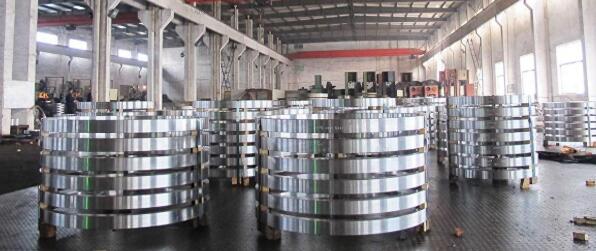Titanium alloy is a material with good mechanical properties and corrosion resistance. It is widely used in many fields. Such as aerospace, chemical, medical and automotive. As per its structure,there are 3 main titanium alloy grades. They are α-type titanium alloy, β-type titanium alloy and α+β-type titanium alloy. Different titanium alloy grades are suitable for different applications based on their different compositions and processing properties. This article will describe the characteristics, grades and applications of common titanium alloys.

α Titanium Alloy
Characteristics:
- Stable α-phase organization. Good corrosion resistance, weldability and high temperature strength. But, room temperature plasticity is low.
- Cannot be strengthened by heat treatment. Mainly rely on alloying to improve performance.
| Grade | China(GB/T) | USA(ASTM) | Main Alloy Element | Chracteristics and Applications |
| TA4 | TA4 | – | Al | High Strength. Used for aircraft structural parts, chemical equipment. |
| TA5 | TA5 | – | Al、Sn、Zr | Good high temperature performance. Used for aircraft engine parts below 500℃. |
| TA7 | TA7 | Ti-5Al-2.5Sn | Al、Sn | Strong oxidation resistance. Used for rocket engine parts, medical implants. |
| TA10 | TA10 | Ti-0.3Mo-0.8Ni | Mo、Ni | Excellent corrosion resistance. Used in marine engineering, chemical pipelines. |
Typical grade analysis:
TA7:
This is a typical alpha-type titanium alloy. It has good oxidation resistance and creep properties at high temperatures. It is often used in certain high-temperature parts of aero-engines. Like compressor blades. In the field of aviation, TA7 can maintain stable performance under high-temperature and high-pressure working environments to ensure the safe operation of the engine.
TA15
It has high strength and good weldability. It is widely used in aircraft structural parts. Such as the wing beams and other key structural parts of the aircraft. Its high strength can meet the requirements of the airplane to withstand a variety of complex loads in the flight process.
β Titanium Alloy
Characteristics
Single β-phase organization. High room temperature strength and good plasticity. Can be significantly strengthened by heat treatment (solid solution + aging). But, the process is complicated and the cost is high.
Typical grade analysis
TB5
- Good cold molding properties and high strength. In the aerospace field of some special structural parts and sporting goods have applications. For example, in the manufacture of high-end golf clubs. TB5 can be cold molded to produce complex shapes of club heads. It also provides enough strength and elasticity.
| Grade | China(GB/T) | USA(ASTM) | Main Alloy Element | Characteristics and Application |
| TB2 | TB2 | – | Mo、Cr、V、Fe | High strength (σb≥1300MPa). Used for aviation fasteners, springs. |
| TB5 | TB5 | Ti-15V-3Cr-3Sn-3Al | V、Cr、Sn、Al | Cold moldable. Used for aerospace structural parts, missile parts. |
| TB6 | TB6 | Ti-6Al-4V(β 态) | Al、V | Excellent overall performance. Used for aero-engine compressor blades. |
| Ti-10V-2Fe-3Al | – | Ti-1023 | V、Fe、Al | High strength, high hardenability. Used for aviation forgings, landing gear. |
α+β type titanium alloy
Characteristics
- consists of a mixture of α- and β-phases. High strength, plasticity and thermal stability. Comprehensive performance can be optimized by heat treatment. It is the most widely used.
| Grade | China(GB/T) | USA(ASTM) | Main Alloy Element | Characteristics and Applications |
| TC4 | TC4 | Ti-6Al-4V | Al、V | Comprehensive and balanced performance. Used in aerospace structural parts, medical equipment, sports equipment. |
| TC11 | TC11 | Ti-6Al-3.5Mo-1.5Zr-0.3Si | Al、Mo、Zr、Si | High strength in high temperature (500℃ lasting strength ≥390MPa). Used for aero-engine disk parts. |
| TC16 | TC16 | Ti-3Al-2.5V | Al、V | Good cold molding properties . Used for aviation conduit, bicycle frame. |
| TC21 | TC21 | – | Al、Mo、Nb、Zr | Ultra-high strength (σb≥1100MPa) for aerospace load-bearing members. |
Typical grade analysis
TC4 (Ti-6Al-4V)
This is one of the most used titanium alloys. It has super comprehensive performance, high strength, good corrosion resistance. In the aerospace field, it is used to manufacture aircraft fuselage structural parts, landing gear. In the medical field, it is used to make artificial joints, bone plates and other implants.
For example, in the manufacture of fighter jets, TC4 can ensure the strength of the fuselage. It can reduce the overall weight of the aircraft and improve flight performance.
TC11
It has high strength and good thermal strength. It is commonly used in high-temperature parts. Such as turbine disks and blades of aviation engines. Under high-temperature and high-stress working conditions, TC 11 can maintain stable performance and ensure efficient engine operation.
Summary
The classification and grade selection of titanium alloys should be based on the mechanical properties. (e.g. strength, plasticity, high-temperature performance), technological requirements (e.g. weldability, moldability) and environmental conditions (e.g. corrosion resistance, low-temperature performance) of the specific use scenario. Among them, α-type titanium alloy focuses on corrosion resistance and high temperature performance. β-type titanium alloy focuses on high strength and processability. α+β-type titanium alloy strikes a balance between the two. It is the most widely used.
If you have need of titanium alloy casting, welcome contact JC Casting. We can provide different Titanium Alloy Grades casting.
